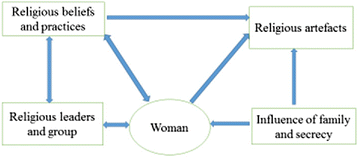Religious beliefs and practices in pregnancy and labour: an inductive qualitative study among post-partum women in Ghana
- PMID: 27267923
- PMCID: PMC4895969
- DOI: 10.1186/s12884-016-0920-1
Religious beliefs and practices in pregnancy and labour: an inductive qualitative study among post-partum women in Ghana
Abstract
Background: Religiosity in health care delivery has attracted some attention in contemporary literature. The religious beliefs and practices of patients play an important role in the recovery of the patient. Pregnant women and women in labour exhibit their faith and use religious artefacts. This phenomenon is poorly understood in Ghana. The study sought to investigate the religious beliefs and practices of post-partum Ghanaian women.
Methods: A descriptive phenomenological study was conducted inductively involving 13 women who were sampled purposively. Individual in-depth interviews were conducted in English, Ga, Twi and Ewe. The interviews were audio-taped and transcribed. Concurrent analysis was done employing the principles of content analysis. Ethical approval was obtained for the study and anonymity and confidentiality were ensured.
Results: Themes generated revealed religious beliefs and practices such as prayer, singing, thanksgiving at church, fellowship and emotional support. Pastors' spiritual interventions in pregnancy included prayer and revelations, reversing negative dreams, laying of hands and anointing women. Also, traditional beliefs and practices were food and water restrictions and tribal rituals. Religious artefacts used in pregnancy and labour were anointing oil, blessed water, sticker, blessed white handkerchief, blessed sand, Bible and Rosary. Family influence and secrecy were associated with the use of artefacts.
Conclusions: Religiosity should be a key component of training health care professionals so that they can understand the religious needs of their clients and provide holistic care. We concluded that pregnant women and women in labour should be supported to exercise their religious beliefs and practices.
Keywords: Christianity; Phenomenology; Prayer; Religious artefacts; Spirituality.
Figures
Similar articles
-
Experiences and perceptions of Ghanaian midwives on labour pain and religious beliefs and practices influencing their care of women in labour.Reprod Health. 2016 Nov 14;13(1):136. doi: 10.1186/s12978-016-0252-7. Reprod Health. 2016. PMID: 27842544 Free PMC article.
-
Initiation of traditional birth attendants and their traditional and spiritual practices during pregnancy and childbirth in Ghana.BMC Pregnancy Childbirth. 2018 Mar 7;18(1):64. doi: 10.1186/s12884-018-1691-7. BMC Pregnancy Childbirth. 2018. PMID: 29514607 Free PMC article.
-
Labour pain experiences and perceptions: a qualitative study among post-partum women in Ghana.BMC Pregnancy Childbirth. 2017 Feb 22;17(1):73. doi: 10.1186/s12884-017-1248-1. BMC Pregnancy Childbirth. 2017. PMID: 28228096 Free PMC article.
-
Looking at infertility through the lens of religion and spirituality: a review of the literature.Hum Fertil (Camb). 2007 Sep;10(3):141-9. doi: 10.1080/14647270601182677. Hum Fertil (Camb). 2007. PMID: 17786646 Review.
-
Socio-cultural beliefs and perceptions influencing diagnosis and treatment of breast cancer among women in Ghana: a systematic review.BMC Womens Health. 2024 May 14;24(1):288. doi: 10.1186/s12905-024-03106-y. BMC Womens Health. 2024. PMID: 38745160 Free PMC article.
Cited by
-
Multilevel analysis of factors associated with assistance during delivery in rural Nigeria: implications for reducing rural-urban inequity in skilled care at delivery.BMC Pregnancy Childbirth. 2018 Nov 8;18(1):438. doi: 10.1186/s12884-018-2074-9. BMC Pregnancy Childbirth. 2018. PMID: 30409121 Free PMC article.
-
A multilevel analysis of social determinants of skilled birth attendant utilisation among married and cohabiting women of Madagascar.Int Health. 2024 Nov 4;16(6):642-652. doi: 10.1093/inthealth/ihad108. Int Health. 2024. PMID: 38011796 Free PMC article.
-
Evaluation of the Clinical and Imaging Findings of Breast Examinations in a Tertiary Facility in Ghana.Int J Breast Cancer. 2021 Jul 19;2021:5541230. doi: 10.1155/2021/5541230. eCollection 2021. Int J Breast Cancer. 2021. PMID: 34336291 Free PMC article.
-
Experiences of midwives on pharmacological and non-pharmacological labour pain management in Ghana.Reprod Health. 2017 Oct 16;14(1):128. doi: 10.1186/s12978-017-0398-y. Reprod Health. 2017. PMID: 29037252 Free PMC article.
-
Implications of self-medication in pregnancy for Safe Motherhood and Sustainable Development Goal-3 in selected Ghanaian communities.Public Health Pract (Oxf). 2020 Jun 21;1:100017. doi: 10.1016/j.puhip.2020.100017. eCollection 2020 Nov. Public Health Pract (Oxf). 2020. PMID: 36101688 Free PMC article.
References
-
- Badoe EA. A brief history of surgery. In: Badoe EA, Archampong EQ, da Rocha-Afodu JT, editors. Principles and practice of surgery including pathology in the tropics. Tema: Ghana Publishing Corp; 2009. pp. 1–11.
-
- Assimeng M. Religion and social change in West Africa: an introduction to the sociology of religion. Accra: Ghana Universities Press; 1989.
-
- Nukunya GK. Tradition and change: an introduction to sociology. 2. Accra: Ghana Universities Press; 2003.
Publication types
MeSH terms
LinkOut - more resources
Full Text Sources
Other Literature Sources
Medical


